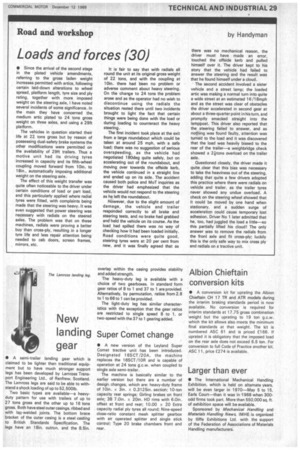Loads and forces (30)
Page 31

If you've noticed an error in this article please click here to report it so we can fix it.
• Since the arrival of the second stage in the plated vehicle amendments, referring to the gross laden weight increases permitted with artics, following certain laid-down alterations to wheel spread, platform length, tyre size and ply rating, together with more imposed weight on the steering axle, I have noted several incidents of some significance. In the main they have concerned the, medium artic plated to 24 tons gross weight on three axles, and using a 29ft platform.
The vehicles in question started their life at 22 tons gross but by reason of possessing dual-safety brake systems the other modifications were permitted on the availability of 29ft trailers. Thus a motive unit had its driving tyres increased in capacity and its fifth-wheel coupling moved forward from 10in. to 18in., automatically imposing additional weight on the steering axle.
The effect of this weight transfer was quite often noticeable to the driver under certain conditions of load or part load, and this particularly applied where radial tyres were fitted, with complaints being made that the steering was heavy. It was even suggested that power steering was necessary with radials on the steered axles. The problem was that on these machines, radials were proving a better buy than cross-ply, resulting in a longer tyre life and less repair attention being needed to cab doors, screen frames, mirrors, etc. It is fair to say that with radials all round the unit at its original gross weight of 22 tons, and with the coupling at 10in, there had been no problem or adverse comment about heavy steering. On the change to 24 tons the problem arose and as the operator had no wish to discontinue using the radials the situation rested there until two incidents brought to light the fact that certain things were being done with the load or during loading to counteract the heavy steering.
The first incident took place at the exit from a large roundabout which could be taken at around 25 mph, with a safe load: there was no suggestion of serious overspeeding, as the vehicle had negotiated 180deg quite safely, but on accelerating out of the roundabout, and moving over towards the offside kerb, the vehicle continued in a straight line and ended up on its side. The accident caused both police and MoT inquiries as the driver had emphasized that the vehicle would not respond to the steering as he left the roundabout.
However, due to the slight amount of damage, the vehicle and trailer responded correctly to all brake and steering tests, and no brake had grabbed and held the vehicle on its course. As the load had spilled there was no way of checking how it had been loaded initially. Road conditions were quite good, steering tyres were at 20 per cent from new, and it was finally agreed that as there was no mechanical reason, the driver must have made an error, touched the offside kerb and pulled himself over it. The driver kept to his story that the vehicle had failed to answer the steering and the result was that he found himself under a cloud.
The second accident involved a sister vehicle and a street lamp; the loaded artic was making a normal turn into quite a wide street at an estimated 16 /18mph and as the street was clear of obstacles the driver accelerated in second gear at about a three-quarter point in his turn, and promptly smacked straight into the lamppost. This driver also reported that the steering failed to answer, and as nothing was found faulty, attention was turned to the load and it was discovered that the load was heavily biased to the rear of the trailer—a weighbridge check showed a 2i-tons overload on the trailer axle.
Questioned closely, the driver made it quite clear that this bias was necessary to take the heaviness out of the steering, adding that quite a few drivers adopted this practice where there were radials on vehicle and trailer, as the trailer tyres never showed any undue overload. A check on the steering wheel showed that it could be moved by one hand when stationary, and a sudden surge of acceleration could cause temporary lost adhesion. Driver No 1 later admitted that he, too, had juggled the load a little—so this partially lifted his cloud! The only answer was to remove the radials from the front axle and fit cross-ply; luckily this is the only safe way to mix cross ply and radials on a tractive unit.
























































































































































